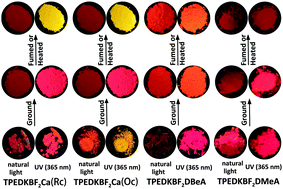Multi-state emission properties and the inherent mechanism of D–A–D type asymmetric organic boron complexes†
Abstract
Fluorescence emission properties in the single molecule, crystalline and amorphous state are key factors determining the application fields and scope of luminogens. However, the luminescence efficiency of luminogens is usually inconsistent in these three existing forms. To explore multi-state emission properties and the inherent mechanism of luminogens, and obtain rare mechanical force-induced luminescent enhancement and multicolor switching, three D–A–D (Donor–Acceptor–Donor)-type organic boron complexes containing tetraphenylethylene (TPE) and different aromatic amine units are designed and synthesized. TPEDKBF2DMeA, TPEDKBF2Ca and TPEDKBF2DBeA respectively exhibit aggregation caused quenching (ACQ), AIE and dual-state emission (DSE) fluorescence characters. The orange crystals (Oc) of TPEDKBF2Ca show a twisted molecular configuration and head-to-tail J-type stacking mode, while the red crystals (Rc) of TPEDKBF2Ca form scarce super unit cells with the help of two face-to-face antiparallel dimers and the other four single molecules. TPEDKBF2DBeA adopts an antiparallel head-to-head J-type stacking mode, leading to π–π stacking interactions. The faint fluorescence emission of TPEDKBF2DMeA is attributed to parallel J-type stacking based on theoretical calculations. Additionally, TPEDKBF2Ca, TPEDKBF2DBeA and TPEDKBF2DMeA in turn display reversible multi-color switching, blue-shifted fluorescence emission and remarkable luminescent enhancement, and negligible wavelength shift. Detailed single crystal analyses and theoretical calculations indicate that the molecular stacking mode is the critical factor affecting the optical and mechanochromic properties. Meanwhile, this work demonstrates that aryl amine substituents can tune the multistate emission properties of organic fluorophores, which provides a deep understanding for molecular design of multi-state emitters and mechanochromic materials.



 Please wait while we load your content...
Please wait while we load your content...